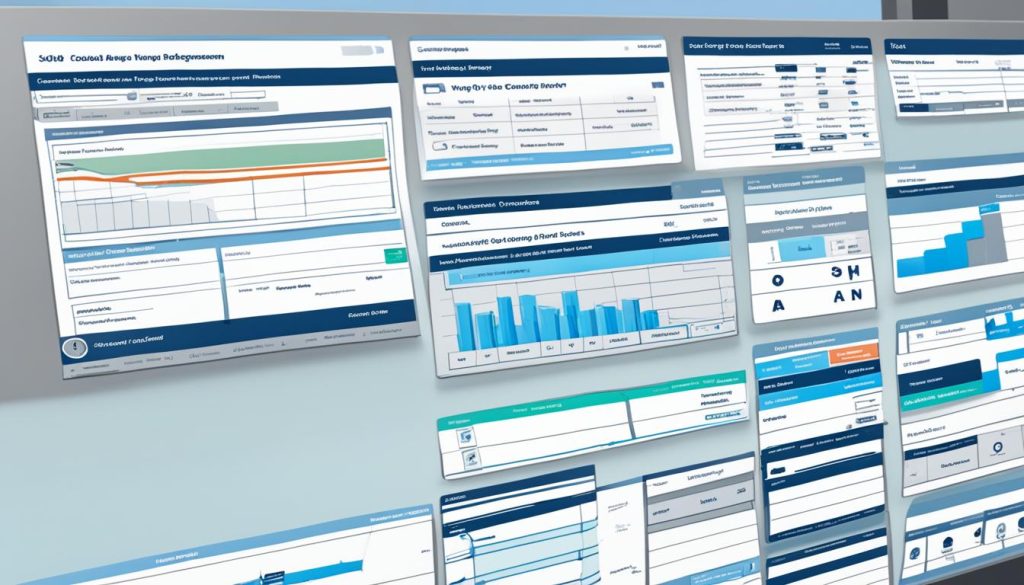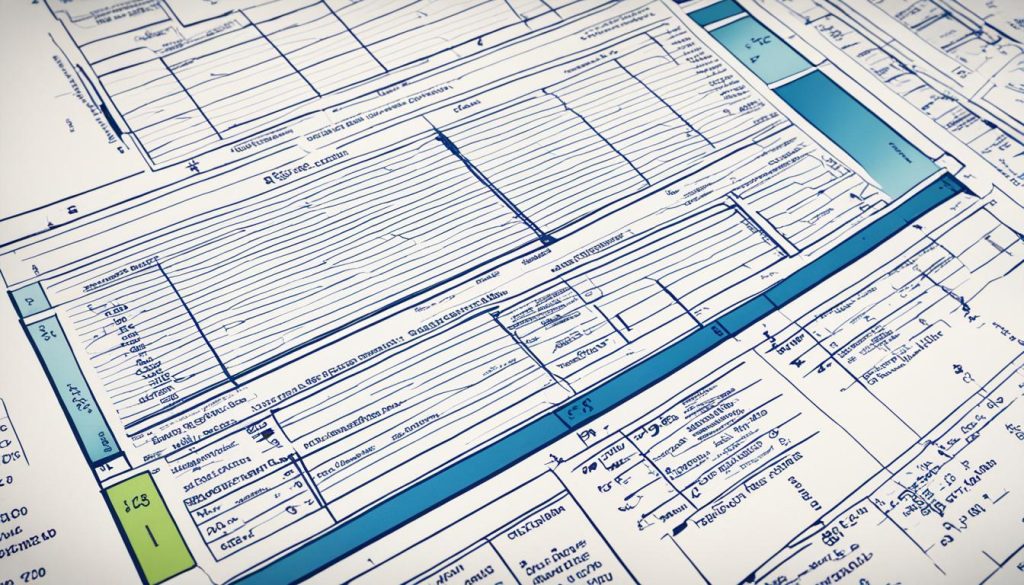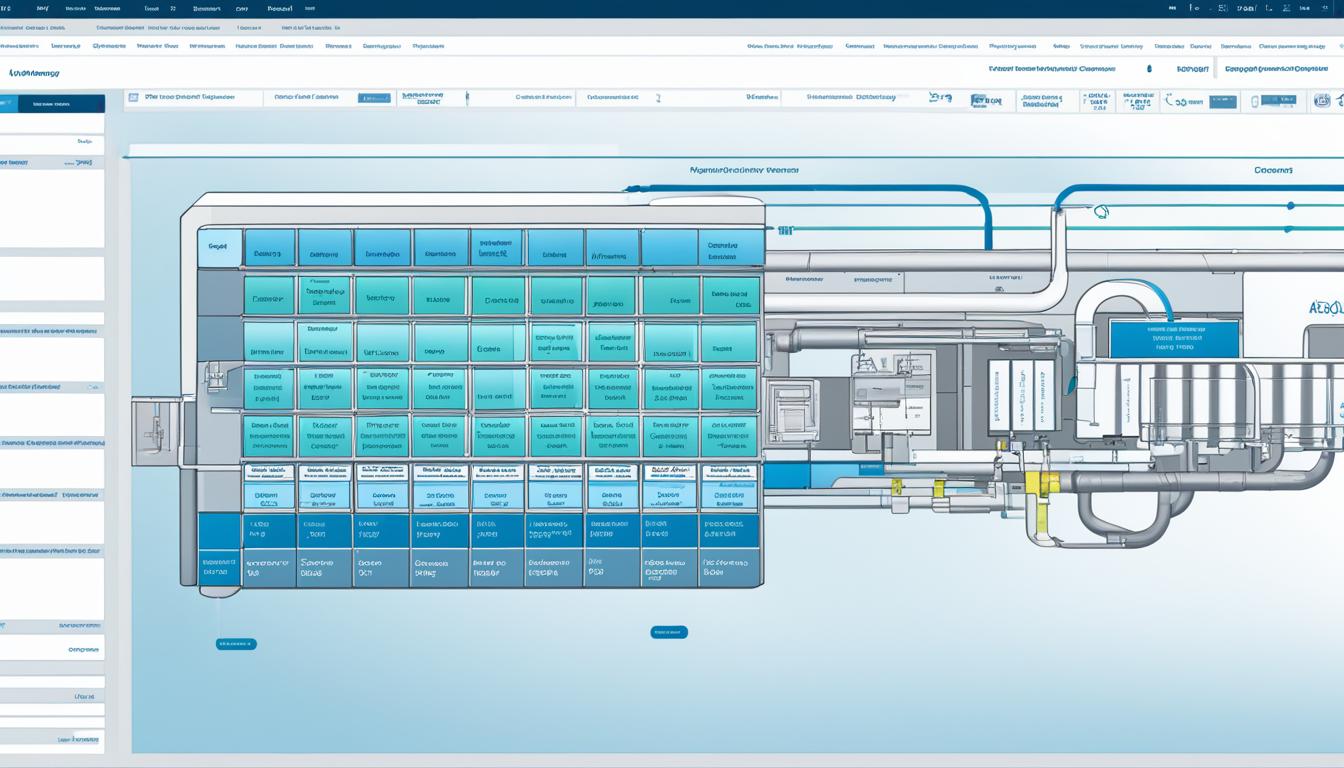Creating professional HVAC reports is easier with duct design software. It helps streamline your work and makes your reports more accurate. This tool lets you figure out the best duct sizes and work with CAD systems. It also helps you make reports that follow industry standards.
Duct design software makes writing HVAC reports simpler by doing complex calculations for you. It also shows your designs in a clear way. Using this tech, you’ll make your reporting faster and give your clients top-notch documents.
This software uses methods like static regain, equal friction, and constant velocity to find the right duct sizes. These methods make sure your HVAC reports follow ASHRAE and SMACNA rules. This shows you’re serious about professional reporting.
Understanding the Importance of Professional HVAC Reports
Professional HVAC reports are key to successful projects. They are vital for documenting, writing, and managing HVAC projects. Let’s see why these reports are so important for your HVAC projects.
The role of accurate documentation in HVAC projects
Accurate documentation is crucial for project success. It helps track system designs, check duct layouts, and figure out airflow needs. With good technical writing, you can spot problems early, avoiding big costs later.
Benefits of using duct design software for reporting
Duct design software makes HVAC project management easier. It quickly checks duct sizes, airflow, and system performance. This software helps you make detailed reports with:
- Detailed duct sizing information
- Airflow calculations
- Pressure loss analysis
- Equipment specifications
Meeting industry standards and regulations
Professional HVAC reports make sure you follow industry standards. They help you stick to ASHRAE and SMACNA rules, which are key for project approval and quality. With duct design software, making reports that meet these standards is easy.
| Report Element | Importance | Impact on Project |
|---|---|---|
| Accurate Documentation | High | Prevents errors, saves time |
| Duct Design Software | Medium | Improves efficiency, reduces costs |
| Industry Compliance | Critical | Ensures project approval, quality |
By focusing on professional HVAC reports, you lay the groundwork for successful projects. These reports boost your technical writing and improve HVAC project management.
Selecting the Right Duct Design Software for Your Needs
Choosing the best duct design software is key for your HVAC projects. You want a tool that makes your work easier and gives you accurate results. Let’s look at what features to consider when picking software for your duct design needs.
First, find software that offers various calculation methods. Make sure it includes static regain, equal friction, and constant velocity calculations. These are crucial for accurate HVAC designs and following industry standards.
It’s also important to have CAD system integration. This lets you easily move your duct designs into detailed drawings. This saves time and cuts down on mistakes. The software should work well with popular CAD tools used in HVAC design.
- Static regain, equal friction, and constant velocity calculations
- CAD integration for easy design transfer
- Noise level analysis and attenuation reporting
- Comprehensive output reports for professional reporting
- Built-in HVAC templates and symbol libraries
Noise analysis is key in HVAC design. Pick duct design software that has tools for checking and reducing noise levels. This helps make spaces quieter and more comfortable for people.
Professional reporting is a must for showing your work to clients and others. Look for software that makes detailed, customizable reports. These reports should be clear and look good.
Last, think about collaboration features. If you work with a team, choose software that lets you share and edit designs in real-time. This helps with better communication and efficiency in your HVAC projects.
Key Features of Effective HVAC Reporting Software
Effective HVAC reporting software is key for precise duct sizing and HVAC calculations. It makes technical writing easier and boosts project efficiency. Let’s look at the main features that make HVAC reporting software a must-have for professionals.
Calculation Methods
Top HVAC software offers various calculation methods for duct sizing. These include:
- Static regain: Balances pressure drops across the system
- Equal friction: Maintains consistent pressure loss per unit length
- Constant velocity: Keeps air speed uniform throughout the ductwork
Each method has its own use, helping engineers fine-tune airflow and system performance.
CAD Integration
Seamless CAD integration is a big win for HVAC pros. It lets you:
- Directly import architectural plans
- Automatically route ducts based on calculations
- Get real-time updates to drawings as changes happen
This integration cuts down on design time and lowers the chance of mistakes.
Noise Analysis and Attenuation Reporting
Advanced HVAC software comes with noise analysis tools for comfort and to follow rules. You’ll find features like:
| Feature | Benefit |
|---|---|
| Sound power level calculations | Predicts noise at different points in the system |
| Attenuation modeling | Offers noise reduction strategies |
| Frequency analysis | Finds sound frequencies that need attention |
With these features, HVAC reporting software helps engineers make detailed, precise, and professional reports. These reports meet industry standards and what clients expect.
Setting Up Your Project in Duct Design Software
Starting your HVAC project management journey begins with setting up your project in duct design software. This step is key for making accurate calculations and detailed reports. Let’s look at how to set up your project with industry-standard tools.
Entering General Project Data
First, enter important project details into your duct design software. This includes the project name, location, and client info. Many software packages have templates to help you, saving time and keeping projects consistent.

Defining System and Fan Specifications
Then, define the system and fan specifications. This is vital for precise HVAC calculations and detailed reports. You should input details like:
- Fan type and model
- Allowable air velocities
- Desired noise levels
- System operating pressures
Inputting Trunk and Runout Data
The last step is to enter trunk and runout data. This info is crucial for your duct design and detailed reports. Key elements to include are:
| Data Type | Description | Importance |
|---|---|---|
| Duct Length | Total length of each duct section | Crucial for pressure loss calculations |
| Connection Numbers | Identifiers for duct connections | Ensures proper system mapping |
| Material Type | Duct material specifications | Affects friction and heat transfer |
| Insulation R-values | Thermal resistance of insulation | Impacts energy efficiency |
| Fitting Quantities | Number and types of fittings used | Influences pressure drop calculations |
| Runout CFM Values | Airflow rates for terminal branches | Essential for balancing system design |
By carefully entering this data, you prepare for accurate duct sizing, efficient airflow, and detailed reports. Remember, the quality of your input greatly affects your HVAC project management results.
Create Professional HVAC Reports Using Duct Design Software
Using duct design software makes writing HVAC reports easier and more accurate. These tools come with templates, symbols, and calculations. They help you make detailed documents for your projects.
To begin, put your project’s details into the software. This includes general info, system specs, and duct details. The software then creates detailed reports from this data.
Professional HVAC reporting includes several important parts:
- General project data
- Trunk and runout sizing information
- Noise analysis documentation
- Airflow calculations
- Equipment specifications
Many duct design software programs work with CAD systems. This lets you easily import and export your duct designs. It makes your reports look better and keeps everything consistent.
| Report Component | Description | Importance |
|---|---|---|
| Project Overview | General information about the HVAC project | Provides context for the entire report |
| Duct Sizing | Detailed calculations for trunk and runout sizes | Ensures proper airflow throughout the system |
| Noise Analysis | Evaluation of potential noise issues and solutions | Addresses comfort concerns for occupants |
| Equipment Specifications | Details on HVAC units and components | Guides installation and maintenance processes |
Using duct design software for reporting helps you make detailed, accurate, and good-looking HVAC reports. They meet industry standards and what clients expect.
Optimizing Duct Sizing for Efficient Airflow
Getting duct sizing right is key for efficient airflow in HVAC systems. Advanced calculations help you design your ducts for the best performance. Let’s look at three main ways to size ducts for efficient airflow.
Using the Static Regain Method
The static regain method keeps pressure balanced in the duct system. It aims for constant static pressure everywhere. By making ducts the right size, you turn velocity pressure into static pressure for even air distribution.
Applying Equal Friction Calculations
Equal friction calculations keep the pressure loss the same for every duct length. This method makes the system balanced by keeping the pressure drop steady across different parts of the duct. It works well for simple, symmetrical duct setups.
Implementing Constant Velocity Design
Constant velocity design keeps air speed the same everywhere in the system. This is great for industrial settings where air speed matters a lot. It stops dust from settling and keeps ventilation systems efficient.
| Method | Pros | Cons | Best For |
|---|---|---|---|
| Static Regain | Balanced pressure, efficient for long runs | Complex calculations | Large commercial systems |
| Equal Friction | Simple to implement, balanced system | May oversize some sections | Residential and light commercial |
| Constant Velocity | Prevents settling, consistent airflow | Can lead to higher pressure drops | Industrial and material handling |
Duct design software makes these HVAC calculations easier. It lets you quickly check and adjust duct sizes for the best airflow. Using these tools, you can make HVAC systems that work well, meet performance needs, and save energy.
Incorporating ASHRAE Standards into Your Reports
ASHRAE standards are key in HVAC documentation and professional reporting. It’s vital to blend these standards into your reports when using duct design software. This makes sure your work follows industry rules and best practices.
Make sure your duct design software uses the ASHRAE Handbook of Fundamentals and ASHRAE Duct Fitting Database. These tools help with precise calculations and designs. Including specific ASHRAE guidelines in your reports shows you’re serious about quality and following the rules.
- Minimum airflow requirements
- Maximum fan watt draw
- Duct sizing and pressure drop calculations
- Ventilation rates for different space types
- Energy efficiency standards
To follow ASHRAE standards, use software with features that apply these guidelines automatically. This method saves time and lowers the chance of mistakes in your HVAC documents.
| ASHRAE Standard | Application in Reports | Benefit |
|---|---|---|
| Standard 62.1 | Ventilation calculations | Ensures indoor air quality |
| Standard 90.1 | Energy efficiency measures | Promotes sustainable design |
| Standard 55 | Thermal comfort analysis | Improves occupant satisfaction |
Using ASHRAE standards in your reports boosts the quality of your work. It also builds trust with clients and regulatory bodies. Always keep up with the latest changes to these standards to keep your HVAC documents accurate.
Generating Comprehensive Output Reports
Creating professional HVAC reports is key for good technical writing and project documentation. Duct design software makes this easy, letting you make detailed reports on your HVAC system design.
General Project Data Reports
Your HVAC documentation starts with general project data reports. These have important info like client details, project location, and system specs. The software automatically gathers this data, making sure your reports are accurate and consistent.
Trunk and Runout Sizing Information
Trunk and runout sizing is a big part of HVAC documentation. Your duct design software figures out the best sizes for airflow and system needs. It shows these sizes in tables, with details on dimensions, air speeds, and pressure drops for each duct part.

Noise Analysis Documentation
Professional HVAC reports also cover noise concerns. The software gives detailed noise analysis, including sound levels and ways to reduce noise. This ensures your HVAC system is quiet enough for comfort.
| Report Type | Key Information | Benefit |
|---|---|---|
| General Project Data | Client details, location, system specs | Provides project overview |
| Trunk and Runout Sizing | Duct dimensions, air velocities, pressure drops | Ensures optimal airflow |
| Noise Analysis | Sound power levels, attenuation measures | Addresses acoustic comfort |
Using these detailed reports, you can make professional HVAC documentation. It clearly shows the system design, how well it performs, and if it meets standards. This detailed info makes your project clear and helps with smoother implementation.
Visualizing HVAC Designs with Software Tools
Duct design software has changed how we make and show HVAC designs. These tools have many features to help you see complex systems. They make making professional reports easy.
With duct design software, you can use a library of symbols for different HVAC parts. You’ll find symbols for valves, coils, compressors, and more. Just drag and drop these symbols onto your design to quickly make accurate HVAC system models.
One key feature is making floor plan views. These show duct layouts, sizes, and airflow directions. This makes it easy for clients and team members to see the system’s layout and how it works.
You can also export your designs in different formats. PDF and image files are great for sharing. This lets you add detailed visuals to your reports, making communication better with everyone involved.
| Software Feature | Benefit |
|---|---|
| Built-in symbol library | Quick and accurate component representation |
| Floor plan generation | Clear visualization of duct layouts and sizing |
| Export options | Easy sharing and inclusion in reports |
| Airflow direction display | Enhanced system understanding |
Using these tools, you can make HVAC reports that are both informative and good-looking. This makes your work easier and improves how happy clients are with the project.
Collaborating on HVAC Projects with Team Members
Working together as a team is key to successful HVAC project management. Modern tools make it easier to work together and keep everyone informed.
Sharing and editing designs in real-time
Now, HVAC design software lets team members work together on projects at the same time. You can share your designs right away, making it easier to get feedback and solve problems fast. This way, everyone works better together and knows what’s happening at all times.
Integrating with project management platforms
Many HVAC software programs work well with tools like Microsoft Teams or Slack. This means you can talk to your team, keep track of progress, and handle tasks all in one place. It makes everything more efficient and cuts down on misunderstandings.
Utilizing cloud storage for accessibility
Cloud storage like SharePoint or Google Drive is a must for HVAC projects today. These services offer safe, easy access to your designs and reports. You can share files with clients, contractors, and team members easily, keeping everyone updated. Plus, you can see who made changes and keep a record of your project’s history.





0 Comments